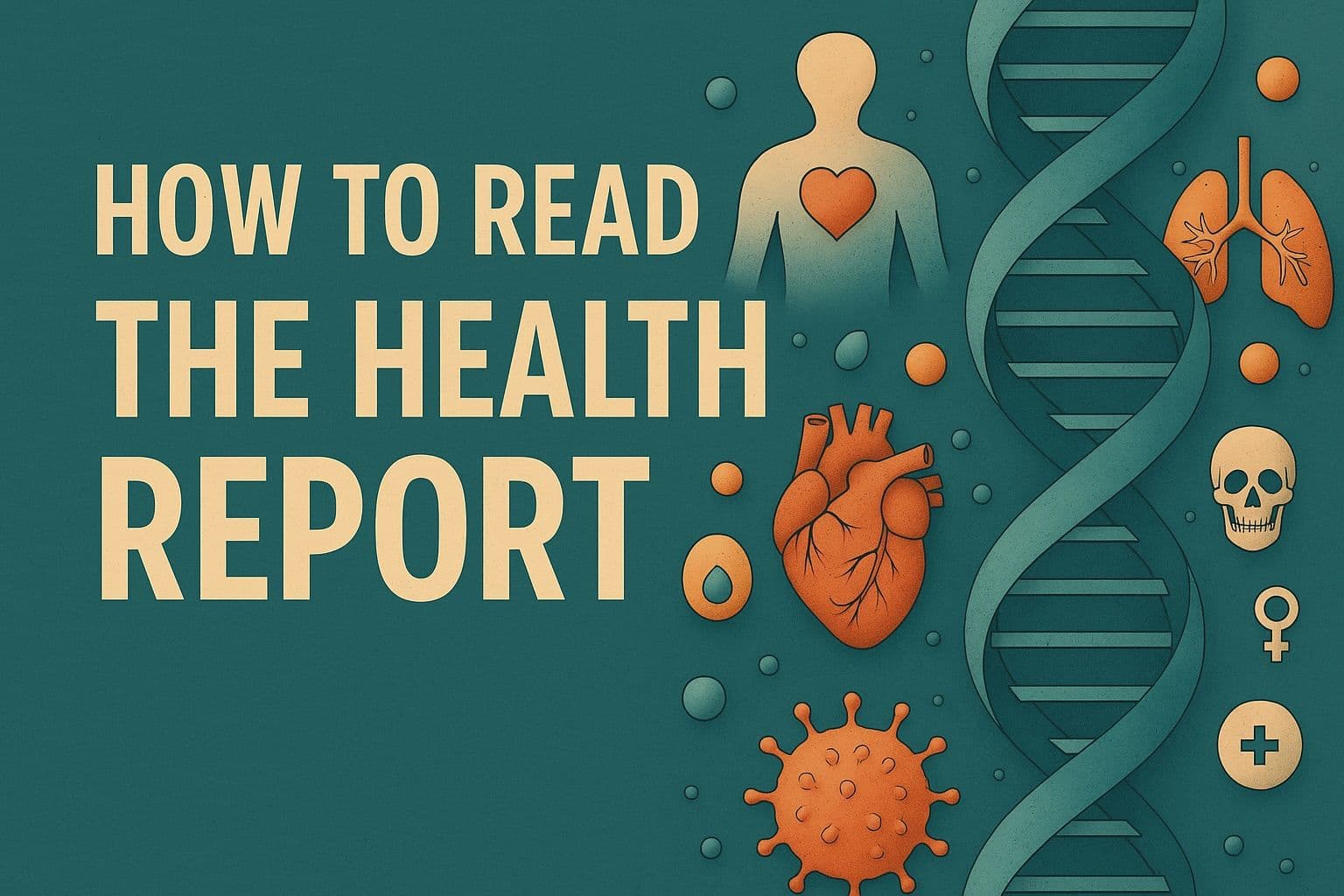How to Read the Health Report?

How to Read the Health Report
Your Full Human Health Report provides insights into how your genetics may influence your health across a wide range of conditions. This article will help you understand what the report includes and how to interpret the results.
⸻
What’s Inside the Report
The report is organized by medical categories. Each section explores your genetic risk for specific conditions within that category.
Report Categories Explained • Cancer Assesses your genetic predisposition to different types of cancer, such as breast, prostate, or colon cancer. These insights are based on variations that may affect how cells grow and repair themselves. • Autoimmune and Inflammatory Diseases Looks at how your genes may influence your risk for conditions where the immune system attacks the body—like rheumatoid arthritis, lupus, or celiac disease. • Cardiovascular Diseases Examines your risk for heart and blood vessel conditions, including high blood pressure, high cholesterol, and stroke. • Neurological and Mental Health Disorders Includes predispositions to conditions that affect brain function and mental health, such as Alzheimer’s disease, depression, anxiety, and Parkinson’s disease. • Infectious Diseases Explores how your genetic profile may affect your vulnerability or resistance to infections like hepatitis, tuberculosis, and viral illnesses. • Respiratory Diseases Covers genetic risks for conditions affecting the lungs and airways, like asthma or chronic obstructive pulmonary disease (COPD). • Gastrointestinal Disorders Focuses on digestion-related conditions like Crohn’s disease, IBS, or lactose intolerance, which may be influenced by inflammation or food processing in the gut. • Endocrine and Metabolic Disorders Looks at genes involved in hormone regulation and metabolism, such as those affecting your risk for diabetes, obesity, or thyroid disorders. • Musculoskeletal Disorders Analyzes risks for issues with bones, joints, and muscles—like osteoporosis, arthritis, and back problems.
⸻
How to Read the Tables
Each condition is accompanied by a table that summarizes your genetic data. Here’s how to understand each column: • SNP (Single Nucleotide Polymorphism) A specific DNA marker (e.g., rs123456) used to identify genetic differences. Each SNP represents a point of variation that may influence your health. • Genotype Your personal result for that SNP—made up of two letters (e.g., AA, CT, GG) representing the variants inherited from your parents. • Risk Allele The version of the gene (A, T, C, or G) that is associated with increased (or sometimes decreased) risk for a specific condition. • Effect (Odds Ratio | Beta) • Odds Ratio (OR): Measures how much the risk allele increases or decreases your chance of having a condition. • OR > 1: increased risk • OR < 1: reduced risk • Beta: Used for continuous traits (like blood pressure); it shows the direction and strength of the effect (positive = increase, negative = decrease). • Studies (PubMed IDs) Scientific studies that back up the association. Each ID links to a research paper in the PubMed database if you want to explore the evidence further.
⸻
How Total Risk Scores Are Calculated
To give a simplified summary of your genetic risk, the report combines the effects of all relevant SNPs. This includes: 1. Whether you carry the risk allele. 2. How strong the effect is (via OR or Beta). 3. Whether the effect increases or decreases your risk.
Note: SNPs are combined without accounting for their interaction (no statistical correction for overlap), which may slightly over- or underestimate risk.
⸻
Important Notes
• This is not medical advice. Always talk to a healthcare provider before making health decisions.
• Genetics is just one factor. Your lifestyle, diet, and environment also play a major role in your health.
• Science evolves. New research may refine or change how we interpret these associations.
⸻
Using Your Report
Think of this report as a personalized wellness guide—not a diagnosis. It’s meant to help you: • Understand how your genes might affect your health. • Make more informed decisions about your lifestyle. • Start meaningful conversations with healthcare professionals.